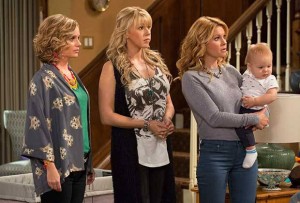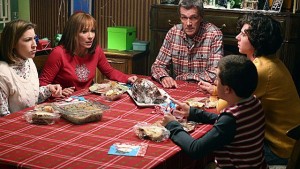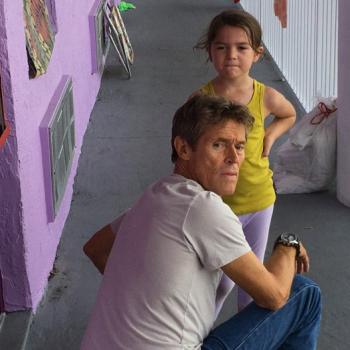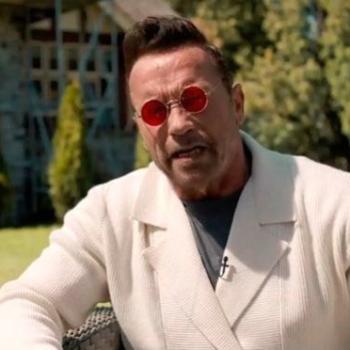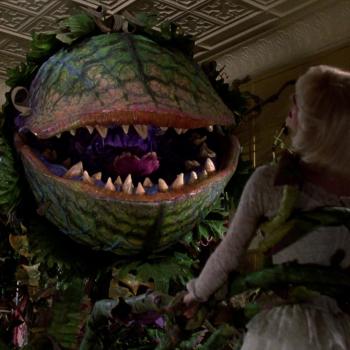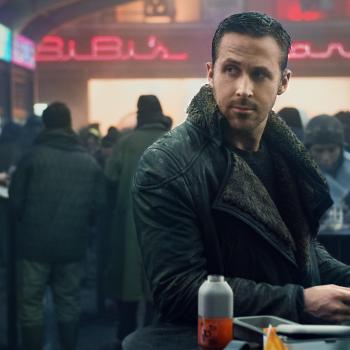After 20 years away, it looks like the Tanners aren’t going anywhere soon.
This week, Netflix announced that it had renewed “Fuller House,” the revival of popular ABC sitcom “Full House,” for a second season. Netflix famously doesn’t release its viewership statistics, but it’s safe to assume that fans of the original series turned out in large numbers for the return of the San Francisco clan.
I understand the excitement. I was a fan of the show when I was a kid, and I watched it for pretty much its entire run. Nostalgia’s a powerful thing, and I can’t begrudge anyone from wanting a revival of their favorite show when I’ve been excited about the resurrection of “Arrested Development,” “Mr. Show,” “24” and “Wet Hot American Summer.” These things rarely turn out well, but seeing your favorite characters return after years away is like having a warm pop culture blanket. I get the appeal, even if adulthood has revealed that “Full House” was a saccharine, painfully cloying sitcom, and I’d hardly argue that a show that lasted nine seasons was unceremoniously canceled. But hey, some things just aren’t for me. And like I said on Facebook earlier, if they announced a “Perfect Strangers” reboot, I’d be asking someone to kick over whatever rock Mark Linn-Baker’s been hiding under.
Here’s the thing, though. This week, I watched the first episode. And it’s not good. I mean, on the one hand, it’s definitely “Full House.” The cute kids are out full force, the jokes are as corny as they’ve ever been, and there’s a random dance number to “The Right Stuff.” It takes less than five minutes for Dave Coulier to break out a Bullwinkle impression, Bob Saget’s still a neat freak and John Stamos says “have mercy.” Everything’s pretty much as I remember it being in the show, down to the Victorian San Francisco home they all live in. The thing that’s changed is me and my tolerance for syrupy, lame jokes.
The pilot feels like a series finale set 20 years too late. It revolves around Danny Tanner (Saget) selling his house, and his family and old friends come back to send him off to L.A. DJ (Candace Cameron-Bure) is now raising kids of her own and she’s a widower, because apparently there’s a spouse-killing curse on the Tanner home. Sister Stephanie (Jodi Sweetin) is a world-famous deejay called — wait for it — DJ Tanner. Obnoxious neighbor Kimmy Gibbler is now divorced, obnoxious neighbor Kimmy Gibbler, with a child in tow and an ex-husband who still longs for her touch. Pretty much everyone is back, including DJ’s old boyfriend, who hits on her almost immediately, and Uncle Jesse (Stamos) and Becky’s surf-dude sons. Actually, I take that back. Missing from action is, of course, Michelle, because Mary Kate and Ashley Olsen declined to participate. Her absence is explained via an in-joke, followed by a fourth-wall breaking glare at the audience that lasts (I’m not kidding) 15 seconds. Have I also mentioned that the pilot is 35 minutes long…about 10 of which are given over to applause anytime a familiar face appears for the first time or a hoary old catchphrase is trotted out?
I can forgive the lame jokes, because that was “Full House’s” stock in trade. It was a warm hug of a show that existed to teach kids life lessons and provide the family with some time to watch TV together each week. But what I can’t forgive is the show’s blatant pandering to nostalgia. The show sets up a new premise — Stephanie and Kimmy move in with DJ after the men move out — but it’s clear that it’s not going to attempt to do anything new with it. Every scene and every joke is a callback to the original series, whether it’s repeating a line verbatim, trotting out Stamos to sing Jesse’s crappy song, having man-child Coulier continue to do cartoon impressions or — in the episode’s most cringe-inducing moment — having the cast sing the “Flintstones” theme song to quiet a crying baby, complete with a split screen to remind us that this is a re-creation of a scene in the original “Full House” pilot. The entire 35 minutes feels less like a real show and more like a Jimmy Fallon sketch where he trots out old stars and the joke is basically, “hey, remember that thing you liked?”
I don’t even know who this show is for, aside from people who loved “Full House” (but can still see it every day on TV Land). It’s proud of its corniness, and its appeal is based on how it mimics something that was popular two decades ago. I would hope kids who grew up on “Full House” have moved on to wittier, better comedy these days. For those who loved the show, how long can they watch the same stories get recycled, and won’t those old jokes wear thin with time?
I know there’s the argument that parents can watch it with their kids. But I don’t know how popular that choice is going to be. On the one hand, the one place that multi-camera sitcoms are thriving (besides CBS) is on the Disney Channel, and “Fuller House” definitely feels in line with their offerings like “Jessie” or “Dog With a Blog.” But “Fuller House” has a weird and icky undercurrent to it. It wants to be squeaky-clean and family friendly, and it spends a lot of time reminding us that Stephanie and DJ were the sweet little girls we grew up with. But then the show turns right around and sexualizes the characters in uncomfortable ways. There are jokes made about the size of Stephanie’s breasts, which are on prominent display through much of the first episode. And there’s a running joke about Kimmy Gibbler’s sexual prowess, and how she knows all the positions of the Kama Sutra. There’s nothing that I would consider overly dirty or smutty, but it’s jarring alongside the show’s otherwise clean reputation.
I will, however, give credit to the actors, who come close to actually making the material work. They understand the beats and rhythms of a sitcom, and it’s kind of endearing to see how much chemistry they maintain after years away. They’re skilled, funny actors who I’d love to see on another, better show (and, indeed, you can see Stamos each week on the much better “Grandfathered.”) But the material is so weak that they end up flailing around in a sea of corny jokes and lame gags.
I know, I know. I shouldn’t care about this. I should live and let live. I don’t begrudge anyone for liking “Fuller House,” and I probably should just realize that this show likely isn’t for me.
But here’s the thing: we live in an era of great TV. Every week, it seems like a phenomenal new show is debuting on network TV, cable or streaming. My choice is no longer about whether a show is good or bad. My choice comes down to whether a show is great enough for me to devote my time to. I haven’t watched “Daredevil” or “Jessica Jones” because I’m too wrapped up in “The People vs. OJ Simpson” or “Better Call Saul.” TV has gotten to the point where calling a show “good” is almost a detriment; it needs to be great.
And mixed in that, but with perhaps a bit less fanfare, is the fact that sitcoms about families are better than ever. Maybe it speaks to our status as boring parents, but one of the highlights of my week is sitting down with my wife to watch “The Middle,” “The Goldbergs” and “Black-ish” (I’ve also heard great things about “Fresh Off the Boat.”) These shows, in a way, carry the seeds of the old TGIF lineup. They’re about families, and many of their plots are just as outlandish. They have children at the center. And there’s usually some sort of life lesson at the end.
But here’s the thing: they’re good. Scratch that, I’m comfortable with calling them great comedies. They take the saccharine sweetness of something like “Full House” and replace it with wit, insight and humor. Their child actors are just as good as the adults (it’s a travesty that “The Middle’s” Eden Sher hasn’t won an Emmy for her work as perpetually clumsy/hopeful Sue Heck). They confront the awkwardness of life and the friction within families; Danny Tanner was always the world’s best dad, but “Goldbergs” protagonist Adam Goldberg refers to family matriarch Beverly as his loving “Smother,” and Jeff Garlin is always calling his kids “morons” as a weird sign of affection. And when necessary, they can discuss serious issues; last week’s “Black-ish” was a powerful examination of police brutality that never felt too much like a Very Special Episode or sacrificed its wit and humor.
More than that, these shows give us a glimpse into people we don’t always see on TV. A family struggling to make their bills each week as life continues to throw them financial challenges. A Jewish family in the 1980s. A wealthy black family wrestling with their cultural identity. These shows feel fresh because they’re not content to just lob out a few lazy jokes; they build an entire world for these characters and give us situations unique to them. And that specificity gives the shows a universality. Even though they looked like us, I never felt like the Tanners of “Full House” represented my life experience; maybe they were an ideal, but it was always an unreachable one. But I can’t tell you how many times my wife and I have watched “The Middle,” “The Goldbergs” or “Black-ish” and then turned to the other and said, “That’s you!” or “That’s my mom/dad/brother/sister.”
In another age, “Fuller House” might be innocuous. But in an age where comedies are exploring the concept of modern families with real insight and humor (seriously, “The Goldbergs” consistently makes me belly laugh), it’s a relic. Hang onto it for nostalgia if you must. But I guarantee its creakiness is going to become more apparent once you watch some of the great TV that’s out there.

